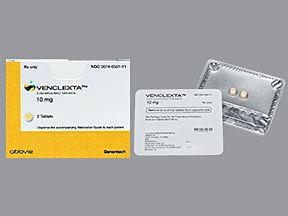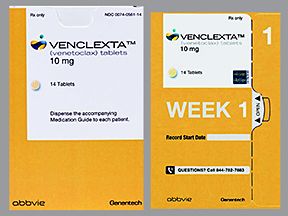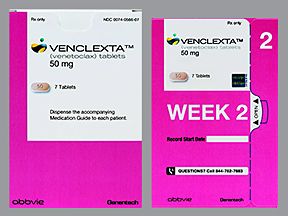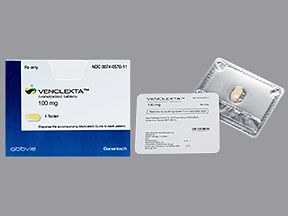Venclexta (venetoclax) is a brand-name prescription medication. The Food and Drug Administration (FDA) has approved it to treat the following in certain situations:
- chronic lymphocytic leukemia
- small lymphocytic lymphoma
- acute myeloid leukemia when taken in combination with Onureg (azacitidine), Dacogen (decitabine), or low dose cytarabine
Venclexta comes as an oral tablet. It belongs to a class of drugs known as B-cell lymphoma 2 (BCL-2) inhibitors. No generic form of Venclexta is available.
For information about Venclexta doses, including the drug’s strengths and how to take Venclexta, keep reading. For a comprehensive look at the medication, see this article.
This article describes typical dosages for Venclexta provided by the drug’s manufacturer. When taking Venclexta, always follow the dosage prescribed by your doctor.
Read below for important information about Venclexta’s dosage for its approved uses.
Venclexta form and strengths
Venclexta comes as an oral tablet in three strengths: 10 milligrams (mg), 50 mg, and 100 mg.
Venclexta is available in a starting pack that includes all the tablets you need for the first 4 weeks of treatment. Because this pack contains different strengths and amounts of tablets, be sure to check that you’re taking the dosage your doctor prescribes.
Typical dosages
Typically, your Venclexta dose will be ramped up (increased) over time. Your doctor will increase your dose each week according to a set schedule. This is not the same as having a loading dose. (With a loading dose, you receive a higher amount of the drug at the start of treatment so it can begin working quickly. Then the dose is gradually decreased.)
The ramp-up schedule of Venclexta helps prevent a problem known as tumor lysis syndrome. It occurs when cancer cells break down and release certain substances into your blood. For details, see this article.
The following information describes dosages that are commonly used or recommended. However, be sure to take the dosage your doctor prescribes for you. Your doctor will determine the best dosage to fit your needs.
Dosage for chronic lymphocytic leukemia
Venclexta dosing for chronic lymphocytic leukemia (CLL) begins with a 5-week ramp-up. You’ll take a higher dose of medication each week. For details, see the chart below. (Milligrams is abbreviated as “mg.”)
| Week | Dose per day |
| 1 | 20 mg |
| 2 | 50 mg |
| 3 | 100 mg |
| 4 | 200 mg |
| 5 and later | 400 mg |
Your doctor may prescribe Venclexta as your only treatment for CLL. Or they may prescribe it in combination with Gazyva (obinutuzumab) or Rituxan (rituximab), which are chemotherapy drugs. If you’re prescribed one of these other drugs, your doctor may have you start taking it before or during your Venclexta treatment. You’ll likely continue taking that drug while you take Venclexta.
Your doctor can instruct you on the dosing schedules for obinutuzumab and rituximab when they’re prescribed with Venclexta.
Dosage for small lymphocytic lymphoma
Venclexta dosing for small lymphocytic lymphoma (SLL) begins with a 5-week ramp-up. You’ll take a higher dose of medication each week. For details, see the chart below.
| Week | Dose per day |
| 1 | 20 mg |
| 2 | 50 mg |
| 3 | 100 mg |
| 4 | 200 mg |
| 5 and later | 400 mg |
Your doctor may prescribe Venclexta as your only treatment for SLL. Or they may prescribe it in combination with Gazyva (obinutuzumab) or Rituxan (rituximab), which are chemotherapy drugs. If you’re prescribed one of these other drugs, your doctor may have you start taking it before or during your Venclexta treatment. You’ll likely continue taking that drug while you take Venclexta.
Your doctor can instruct you on the dosing schedules for obinutuzumab and rituximab when they’re prescribed with Venclexta.
Dosage for acute myeloid leukemia
Venclexta dosing for acute myeloid leukemia (AML) is based on a 28-day cycle. The dosage your doctor recommends depends on which drug they prescribe with Venclexta.
To treat AML, Venclexta may be used in combination with Onureg (azacitidine), Dacogen (decitabine), or cytarabine. Your doctor can instruct you on the dosing schedules for these drugs.
Venclexta dosing for AML is ramped up over 3 or 4 days. You can refer to the chart below for more information.
| Day | Dose per day |
| 1 | 100 mg |
| 2 | 200 mg |
| 3 | 400 mg |
| 4 and later when taken with azacitidine or decitabine | 400 mg |
| 4 and later when taken with low dose cytarabine | 600 mg |
Long-term treatment
Venclexta is meant to be used as a long-term treatment.
Venclexta for CLL or SLL
If you’re prescribed Venclexta alone for CLL or SLL, you’ll likely take it as long as you and your doctor determine it’s safe and effective.
If you’re prescribed Venclexta with obinutuzumab, you’ll usually continue this treatment for 1 year.
If your doctor prescribes Venclexta with rituximab, you’ll likely continue this treatment for 2 years.
Venclexta for AML
When Venclexta is used to treat AML, you’ll likely keep taking it with azacitidine, decitabine, or cytarabine for as long as they’re safe and effective. You and your doctor can determine this.
If you miss a dose of Venclexta by less than 8 hours, take the missed dose right away. Then take your next scheduled dose as usual.
If you miss a dose by more than 8 hours, skip the missed dose. Then take the next dose at the usual time.
If you vomit after taking Venclexta, do not take any extra doses. You should take your next dose at the usual time the next day.
To help make sure that you don’t miss a dose, try using a medication reminder. This can include setting an alarm or using a timer. You could also download a reminder app on your phone.
The Venclexta dosage your doctor prescribes will depend on several factors. These include:
- the type and severity of the condition you’re taking Venclexta to treat
- if you develop any side effects while taking Venclexta
- how well your liver works
- if you take certain other medications with Venclexta
- your age
Other medical conditions you have can also affect your Venclexta dosage.
Dosage adjustments
There may be reasons why your doctor will prescribe a higher or lower dosage of Venclexta. For example, if you take certain medications along with Venclexta, your doctor may lower your Venclexta dosage. These medications can include:
- drugs known as CYP3A4 inhibitors, such as the antifungal posaconazole (Noxafil)
- P-glycoprotein inhibitor drugs, such as the antibiotic erythromycin (Ery-tab, Erygel)
If you have serious liver problems, you may be prescribed a lower dosage of Venclexta.
Venclexta comes as an oral tablet that you’ll swallow whole. You should not crush, chew, or break the tablet. If you have trouble swallowing tablets, see this article for tips on how to take this form of medication. You can also talk with your doctor or pharmacist.
You’ll take each dose with a meal and some water.
Drinking water
You’ll need to drink 56 ounces (about six to eight glasses) of water during these days before and throughout your Venclexta treatment:
- 2 days before your first dose
- 1 day before your first dose
- when you take your first dose
- each time your doctor increases your dose
Drinking the water is meant to help prevent a problem known as tumor lysis syndrome. It occurs when cancer cells break down and release certain substances into your blood. For details, see this article.
Avoiding certain foods
It’s important to avoid consuming grapefruit, grapefruit juice, star fruit, and Seville oranges during your treatment. These foods and drinks may raise the level of Venclexta in your body, which could increase the risk of side effects. (For details about Venclexta’s side effects, see this article.)
Timing
Try to take your dose at the same time each day. This helps maintain a steady level of Venclexta in your system so it can work effectively.
If you’re using the Venclexta starting pack for chronic lymphocytic leukemia, you can refer to this calendar from the drug’s manufacturer. It shows specific information about how many tablets to take each day. It also shows how your dosage will increase over 5 weeks. The Venclexta starting pack can also be used for small lymphocytic lymphoma, so ask your doctor if you can use the same calendar.
If you’re taking Venclexta for acute myeloid leukemia, you can use this calendar. It’s blank, so you can add the dates to remind you when to take your doses.
Accessible drug labels and containersIf you’re having trouble reading your prescription label, talk with your doctor or pharmacist. Some pharmacies offer labels with large print, braille, or a code you scan with a smartphone to convert text to speech. If your local pharmacy doesn’t have these options, your doctor or pharmacist might be able to recommend a pharmacy that does.
You can also talk with your pharmacist if you’re having trouble opening Venclexta packaging. If you’re using a Venclexta starting pack, keep the medication in it. You should not transfer the tablets to a different container, such as a pill box.
It’s important that you do not use more Venclexta than your doctor prescribes. For some medications, taking more than the recommended amount may lead to side effects or overdose.
If you take more than the recommended amount of Venclexta
Call your doctor right away if you believe you’ve taken too much Venclexta. Another option is to call the American Association of Poison Control Centers at 800-222-1222 or use its online tool. If you have severe symptoms, immediately call 911 or your local emergency number, or go to the nearest emergency room.
The dosages in this article are typical dosages provided by the drug’s manufacturer. If your doctor recommends Venclexta for you, they will prescribe the dosage that’s right for you. Always follow the dosage that your doctor prescribes for you.
As with any drug, never change your dosage of Venclexta without your doctor’s recommendation. If you have questions about the dosage of Venclexta that’s right for you, talk with your doctor.
Besides learning about dosage, you may want other information about Venclexta. These additional articles might be helpful:
- More about Venclexta. For information about other aspects of Venclexta, refer to this article.
- Side effects. To learn about side effects of Venclexta, see this article. You can also look at the Venclexta prescribing information.
- Drug comparison. Find out how Venclexta compares with Imbruvica and Daurismo.
- Details about your condition. For details about your condition, see our cancer hub and lists of leukemia articles and lymphoma articles. You can also refer to this article for information about Venclexta and acute myeloid leukemia.
Disclaimer: Medical News Today has made every effort to make certain that all information is factually correct, comprehensive, and up to date. However, this article should not be used as a substitute for the knowledge and expertise of a licensed healthcare professional. You should always consult your doctor or another healthcare professional before taking any medication. The drug information contained herein is subject to change and is not intended to cover all possible uses, directions, precautions, warnings, drug interactions, allergic reactions, or adverse effects. The absence of warnings or other information for a given drug does not indicate that the drug or drug combination is safe, effective, or appropriate for all patients or all specific uses.




